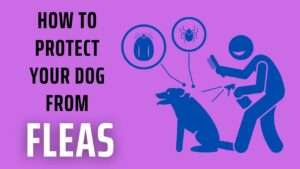Imagine your furry friend, constantly scratching, gnawing, and licking themselves raw. This scenario is all too familiar for many dog owners dealing with Flea Allergy Dermatitis (FAD). But what exactly is FAD, and how can you alleviate your pup’s discomfort? In this comprehensive guide, we delve into the world of Flea Allergy Dermatitis in dogs, exploring its causes, symptoms, diagnosis, treatment, and prevention strategies. Let’s embark on a journey to understand and combat this common canine ailment.
Contents Overview
What is Flea Allergy Dermatitis?
Flea Allergy Dermatitis (FAD) is an allergic skin condition in dogs caused by their hypersensitivity to proteins in flea saliva. Even a single flea bite can trigger an exaggerated immune response, leading to intense itching, inflammation, and skin lesions. It is one of the most common dermatological issues affecting dogs worldwide.
Understanding the Itch: How Flea Saliva Causes Havoc
Flea saliva contains various proteins that act as allergens, triggering an allergic reaction in dogs with Flea Allergy Dermatitis (FAD). When a flea bites a sensitive dog, it deposits saliva into the skin, setting off a cascade of immune responses that lead to the characteristic symptoms of FAD:
- Pruritus (Intense Itching): The primary symptom of FAD, pruritus compels affected dogs to scratch, bite, and lick their skin incessantly in an attempt to alleviate discomfort. The itching can be so severe that it disrupts normal behaviors and affects the dog’s quality of life.
- Erythema (Redness): Flea saliva contains substances that induce inflammation in the skin, resulting in erythema, or redness. Affected areas often appear inflamed and irritated, especially in regions where fleas commonly feed, such as the base of the tail, groin, abdomen, and thighs.
- Papules and Pustules: Inflammatory reactions to flea saliva can lead to the formation of papules and pustules—raised, fluid-filled bumps or pimples on the skin. These lesions may be painful and prone to rupture, leading to further irritation and potential secondary infections.
- Hair Loss: Constant scratching and chewing can cause hair loss, leading to bald patches on the dog’s skin. This hair loss may occur in localized areas, known as “hot spots,” where the dog’s scratching is most intense.
- Skin Thickening and Hyperpigmentation: Prolonged inflammation and trauma from scratching can cause the skin to thicken and darken in color over time. This thickened, hyperpigmented skin is more susceptible to further irritation and secondary infections.
- Secondary Infections: Persistent scratching and open wounds create an ideal environment for bacteria and yeast to proliferate, leading to secondary bacterial or fungal infections. These infections exacerbate the dog’s discomfort and may require additional treatment with antibiotics or antifungals.
Diagnosing Flea Allergy Dermatitis: Identifying the Culprit
Diagnosing Flea Allergy Dermatitis (FAD) requires a comprehensive approach that considers the dog’s clinical signs, history, and laboratory tests to confirm the presence of flea allergy and rule out other potential causes of dermatitis. Here’s how veterinarians typically diagnose FAD:
- Physical Examination: The veterinarian begins by conducting a thorough physical examination of the dog’s skin, focusing on areas prone to flea infestation and allergic reactions, such as the base of the tail, groin, abdomen, and thighs. They look for signs of flea infestation, including flea dirt (black specks resembling pepper) and flea bite lesions.
- Flea Control: Confirming the presence of fleas on the dog or in its environment is essential for diagnosing FAD. The veterinarian may use a fine-toothed comb to comb through the dog’s fur and collect fleas or flea dirt for microscopic examination. Finding live fleas or evidence of flea infestation supports the diagnosis of FAD.
- Elimination Diet: In some cases, dogs may have concurrent food allergies or other dermatological conditions that contribute to their symptoms. To rule out dietary triggers, the veterinarian may recommend an elimination diet, where the dog is fed a novel protein source and monitored for improvement in skin condition.
- Intradermal Allergy Testing: Allergy testing involves injecting small amounts of allergens, including flea saliva, into the dog’s skin and monitoring for allergic reactions. Intradermal allergy testing helps identify specific allergens that may be contributing to the dog’s symptoms, confirming the diagnosis of FAD.
- Blood Allergy Testing: Blood tests can also be used to identify allergen-specific IgE antibodies in the dog’s bloodstream. Blood allergy testing provides a non-invasive alternative to intradermal testing and may be useful in cases where intradermal testing is not feasible.
- Response to Treatment: Response to flea control measures and symptomatic treatment can also support the diagnosis of FAD. If the dog’s symptoms improve with flea prevention and anti-itch medications, it further strengthens the suspicion of FAD.
Treatment Options: Soothing the Itch
Managing Flea Allergy Dermatitis (FAD) involves a multifaceted approach aimed at relieving itching, reducing inflammation, preventing secondary infections, and eliminating fleas and their offspring. Here are the key treatment options for soothing the itch and alleviating the symptoms of FAD:
- Flea Control: The cornerstone of FAD treatment is effective flea control to prevent further exposure to flea allergens. This involves using veterinarian-recommended flea preventatives, such as topical spot-on treatments, oral medications, or flea collars, to kill fleas on the dog and prevent re-infestation. Flea control should be administered consistently and year-round to all pets in the household.
- Symptomatic Relief:
- Medicated Shampoos: Bathing the dog with medicated shampoos containing soothing ingredients like oatmeal, aloe vera, or medicated anti-itch compounds can help relieve itching and cleanse the skin.
- Topical Sprays and Creams: Anti-inflammatory sprays or creams containing corticosteroids, antihistamines, or other anti-itch ingredients can provide immediate relief from itching and inflammation when applied to affected areas.
- Oral Medications: In cases of severe itching, oral medications such as corticosteroids or antihistamines may be prescribed by the veterinarian to reduce inflammation and alleviate itching. These medications should be used under veterinary supervision to minimize side effects.
- Secondary Infection Management: If the dog develops secondary bacterial or yeast infections due to excessive scratching and skin damage, appropriate antibiotics or antifungal medications may be prescribed by the veterinarian to treat the infections and prevent further complications.
- Allergen-specific Immunotherapy: In cases of severe or refractory FAD, allergen-specific immunotherapy, also known as allergy shots, may be recommended. This treatment involves administering gradually increasing doses of flea allergens to desensitize the dog’s immune system and reduce its allergic response over time. Allergy shots are typically administered by a veterinary dermatologist and require regular monitoring to assess treatment efficacy.
- Preventive Measures: Alongside treatment, preventive measures should be implemented to minimize the risk of FAD recurrence:
- Regular Flea Prevention: Continue administering flea preventatives as directed by the veterinarian to prevent future flea infestations.
- Environmental Control: Regularly vacuuming and cleaning the dog’s living environment, washing bedding, and treating indoor and outdoor areas with flea control products can help eliminate flea eggs, larvae, and adults.
- Avoidance of Allergens: Minimize the dog’s exposure to flea allergens by keeping it indoors during peak flea season, using flea control products on other pets in the household, and avoiding known flea-infested areas.
Prevention is Key: Safeguarding Your Pet
Preventing Flea Allergy Dermatitis (FAD) involves proactive measures to protect your pet from flea infestations and subsequent allergic reactions. By implementing preventive strategies, dog owners can minimize the risk of FAD and promote their pet’s skin health. Here’s how to safeguard your pet through prevention:
- Regular Flea Prevention: Administering monthly flea preventatives year-round is crucial for preventing flea infestations and reducing the risk of FAD. Consult your veterinarian to select the most appropriate flea control product for your pet based on factors such as its age, weight, and health status. Options include topical spot-on treatments, oral medications, flea collars, and injectable products.
- Environmental Control: Fleas thrive in warm, humid environments, so regular cleaning and maintenance of your pet’s living environment are essential for preventing flea infestations. Implement the following environmental control measures:
- Vacuuming: Regularly vacuum carpets, rugs, furniture, and pet bedding to remove flea eggs, larvae, and adults.
- Washing Bedding: Launder your pet’s bedding, blankets, and toys in hot water to kill flea eggs and larvae.
- Outdoor Treatment: Treat outdoor areas such as yards, patios, and kennels with flea control products approved for outdoor use to eliminate flea breeding grounds.
- Routine Veterinary Care: Schedule regular wellness exams with your veterinarian to monitor your pet’s skin health and discuss flea prevention strategies. Your veterinarian can recommend appropriate flea control products, perform flea checks during exams, and address any concerns about flea infestations or allergic reactions promptly.
- Education and Awareness: Educating yourself about FAD, its symptoms, and preventive measures empowers you to advocate for your pet’s health and well-being. Stay informed about the latest flea control products, treatment options, and environmental control techniques recommended by veterinarians and pet health organizations.
- Multi-Pet Household Management: If you have multiple pets, ensure that all animals in the household receive regular flea preventatives and veterinary care to prevent cross-infestation and reduce the risk of FAD. Treat all pets simultaneously to eliminate fleas from the household effectively.
- Avoidance of High-Risk Areas: Minimize your pet’s exposure to known flea-infested areas, such as wooded areas, parks, and outdoor environments frequented by other animals. Keep your pet indoors during peak flea season or use flea control products before venturing into high-risk areas.
- Regular Grooming: Brushing and grooming your pet regularly not only promotes skin and coat health but also helps detect fleas and flea dirt early. Use a fine-toothed flea comb to comb through your pet’s fur, paying close attention to areas where fleas tend to hide, such as the neck, back, and tail base.
Bottom Line
In conclusion, Flea Allergy Dermatitis can wreak havoc on your dog’s comfort and quality of life, but with timely intervention and preventive measures, you can effectively manage this common canine ailment. By understanding the causes, symptoms, diagnosis, treatment options, and prevention strategies outlined in this guide, you can embark on a journey towards alleviating your furry friend’s itch and restoring their skin health. Remember, a proactive approach to flea control and veterinary care is key to safeguarding your pet from the scourge of Flea Allergy Dermatitis.




































+ There are no comments
Add yours